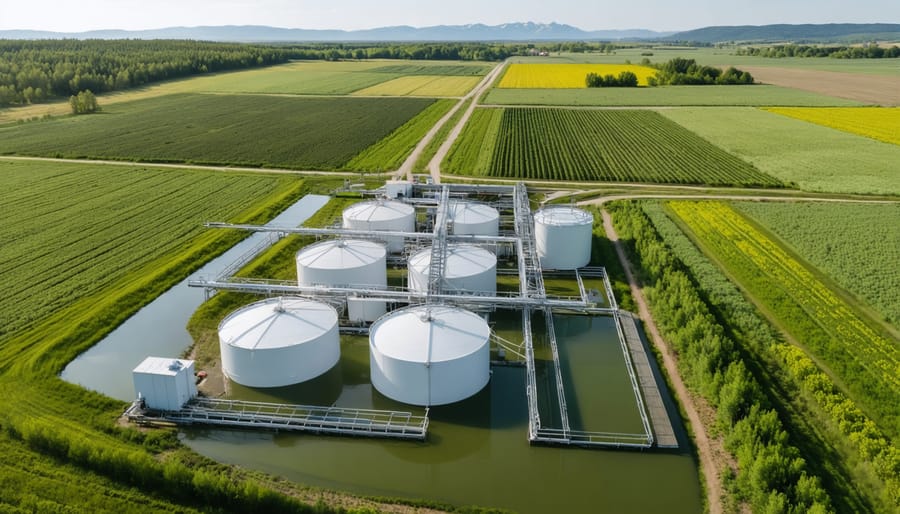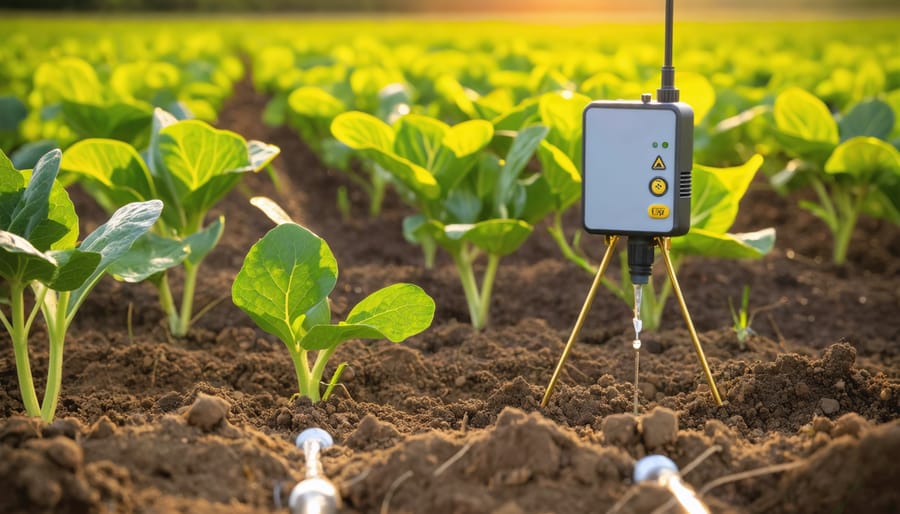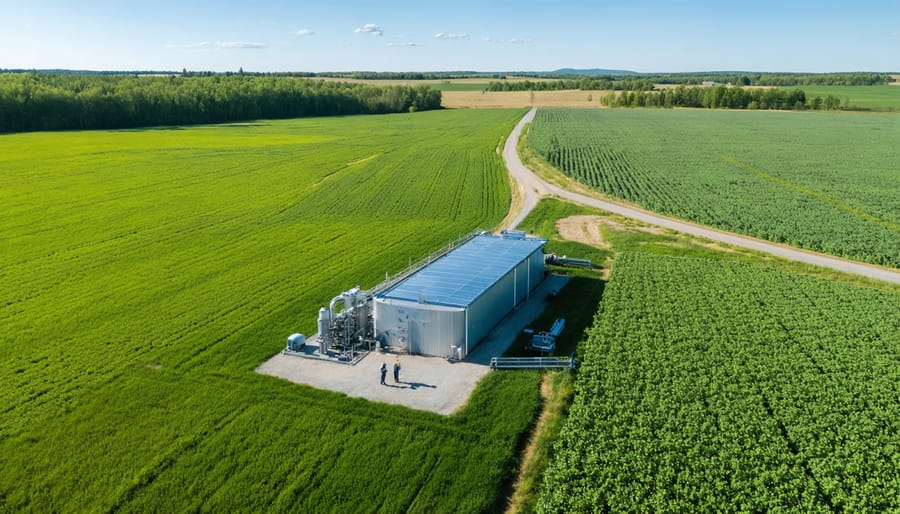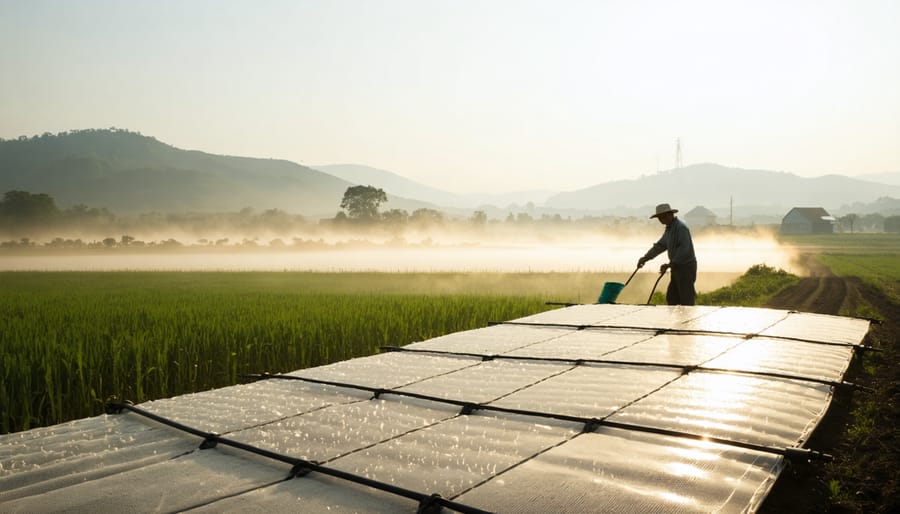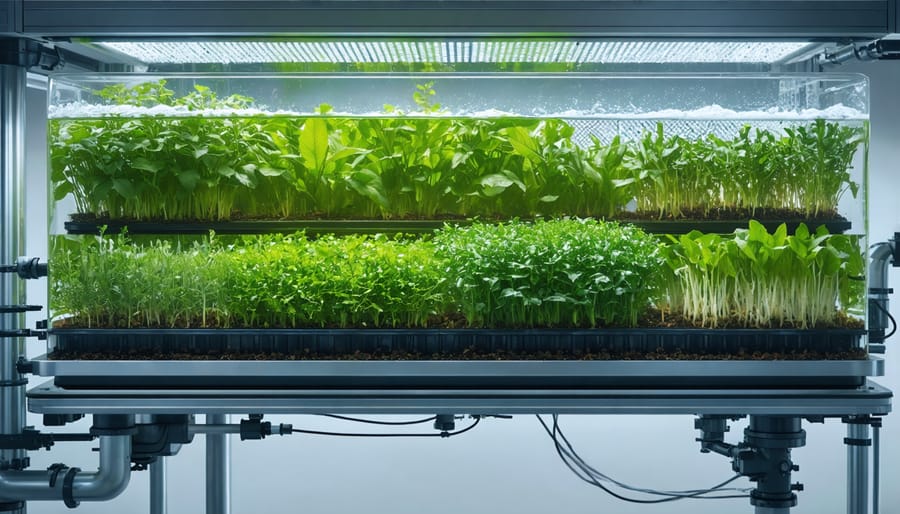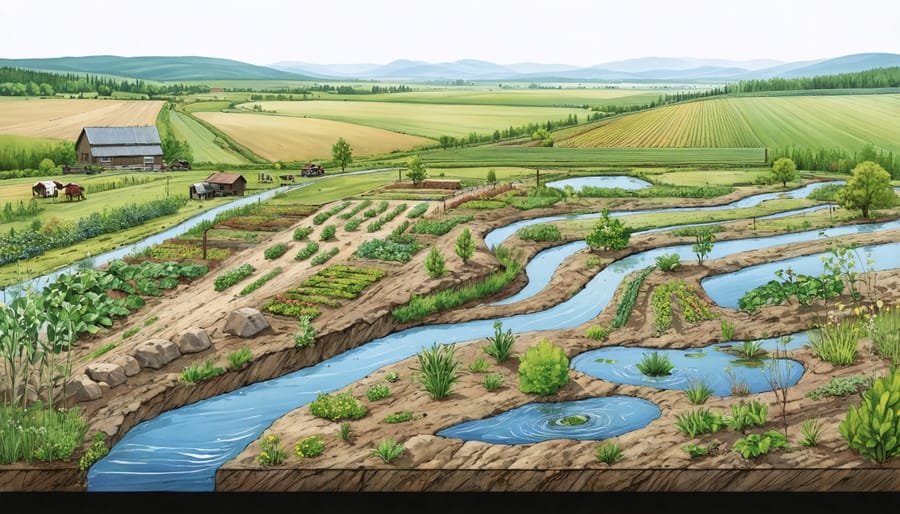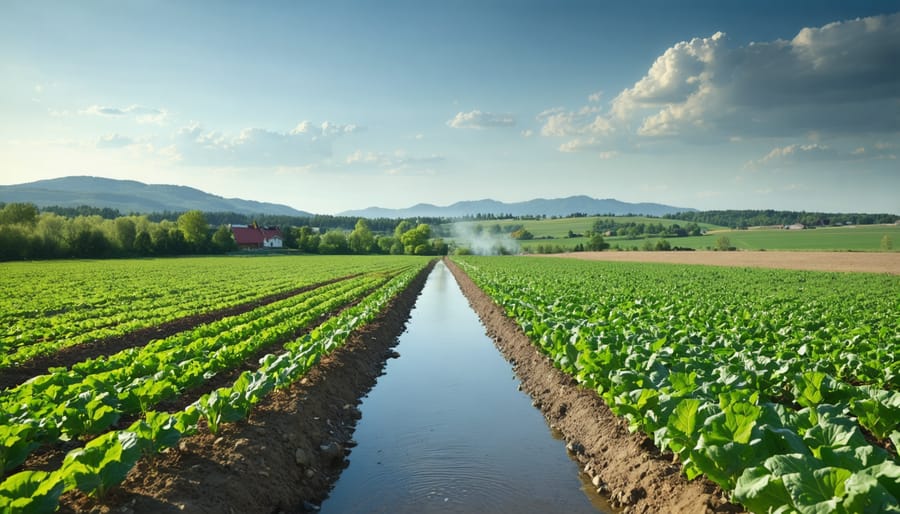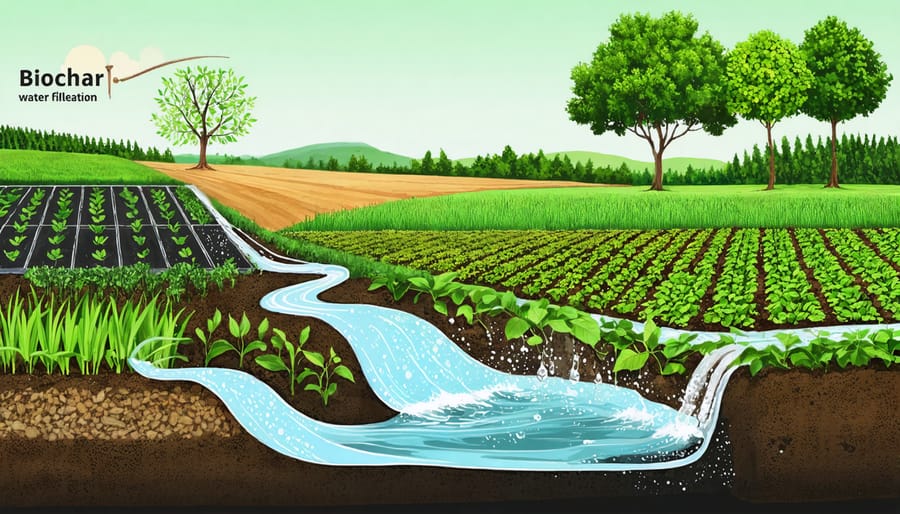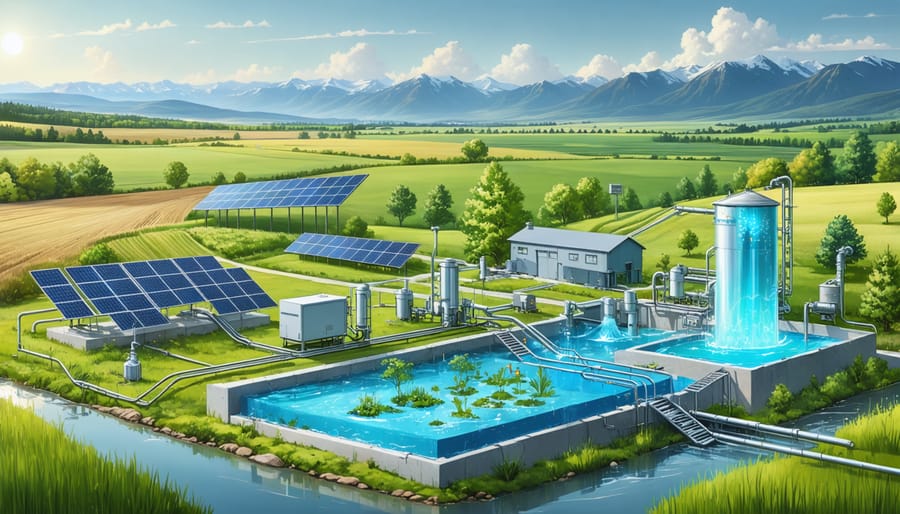Transform your farm’s water infrastructure with Alberta’s new Rural Water Systems Grant, offering up to $50,000 for innovative decentralized water management solutions. This groundbreaking program empowers Alberta farmers to build resilient, sustainable water systems while significantly reducing operational costs.
Recent data shows participating farms have cut water-related expenses by 40% on average, while strengthening their drought resilience through smart collection and storage solutions. From dugouts to advanced filtration systems, the grant covers critical infrastructure that’s reshaping rural water management across the province.
Working directly with over 200 Alberta farmers since 2022, this program has already funded more than 150 successful projects, proving particularly valuable for organic operations seeking to enhance their water security while maintaining certification standards. The streamlined application process, backed by dedicated technical support, ensures farmers can access funding without complex bureaucratic hurdles.
Submit your application today to join the growing network of Alberta farmers pioneering sustainable water solutions. Whether you’re managing 100 hectares or 1,000, this program offers tailored support to match your farm’s unique water management needs.
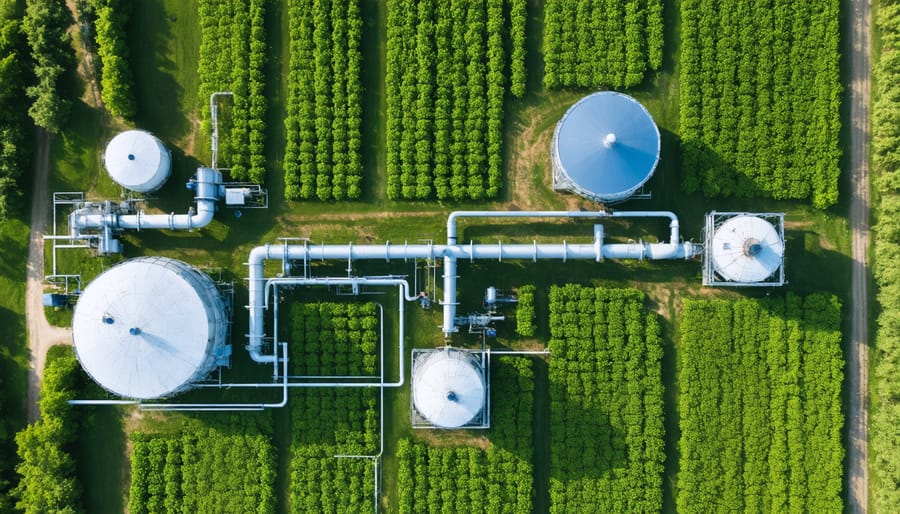
Why Decentralized Water Systems Matter for Organic Farms
Environmental Benefits
Implementing decentralized water systems on rural properties brings significant environmental advantages to both individual farms and the broader ecosystem. These systems reduce the strain on municipal infrastructure and minimize the energy required for water transportation over long distances. By collecting and managing water locally, farms can decrease their carbon footprint while maintaining reliable access to this vital resource.
Natural water filtration methods, such as constructed wetlands and bioswales, help protect local groundwater quality and support native wildlife habitats. These features act as natural buffers, filtering out agricultural runoff and preventing soil erosion. Many Alberta farmers have reported increased biodiversity on their properties after implementing these systems, noting the return of native bird species and beneficial insects.
Sustainable water management also helps farms become more resilient to climate change impacts. By capturing and storing rainwater during wet periods, these systems reduce pressure on aquifers and ensure water availability during dry spells. This approach aligns with traditional Indigenous water stewardship practices and promotes long-term environmental sustainability in our agricultural communities.
The reduced reliance on chemical treatments and energy-intensive pumping systems further enhances the environmental benefits, creating a more sustainable and eco-friendly farming operation.
Economic Advantages
Implementing a decentralized water system through this grant program offers substantial financial advantages for Alberta farmers. Initial studies show that participating farms typically reduce their water-related operating costs by 30-45% within the first year. These water conservation benefits translate to average annual savings of $3,000 to $5,000 for mid-sized operations.
Beyond direct cost savings, these systems enhance operational efficiency through automated monitoring and reduced maintenance requirements. Farmers report spending 60% less time managing water distribution compared to traditional centralized systems. The grant program’s support for modern technology integration, including smart meters and leak detection systems, helps prevent costly water losses and reduces emergency repair expenses.
The program’s cost-sharing structure, typically covering 50-70% of installation costs, significantly reduces the financial burden on farm operators. With an average return on investment period of 3-4 years, participating farms can redirect saved resources toward other essential operations or expansion plans. This makes the program particularly attractive for operations looking to enhance their long-term sustainability while maintaining strong financial performance.
Grant Program Details for Alberta Farmers
Eligibility Requirements
To qualify for the rural decentralized water systems grant program, applicants must be active farmers or agricultural operators in Alberta with a registered farming operation. Your property must be located outside municipal water service boundaries and rely on private water sources. Primary residences and essential agricultural operations on the property are eligible for support.
Applicants must demonstrate a clear need for water system improvements that align with water-smart farming practices. This includes projects such as well drilling, water storage systems, or treatment facilities that enhance water security and quality.
Key requirements include:
– Valid farming operation number registered in Alberta
– Proof of property ownership or long-term lease agreement
– Current water quality test results (within past 6 months)
– Detailed project proposal outlining water system improvements
– Cost estimates from qualified contractors
– Environmental impact assessment (if required)
– Minimum 25% personal contribution to project costs
Priority is given to projects that demonstrate innovative water conservation methods, benefit multiple farming operations, or address critical water access issues. First-time applicants and those implementing sustainable water management solutions receive additional consideration. All proposed systems must comply with provincial water regulations and environmental standards.
Funding Coverage
The Rural Water Systems Grant Program offers substantial financial support, covering up to 50% of eligible project costs to a maximum of $50,000 per farming operation. For multi-user systems serving two or more farming operations, the maximum funding increases to $100,000, encouraging collaborative approaches to water management.
Eligible expenses include essential components such as wells, dugouts, pipelines, pumps, pressure systems, and water storage facilities. The program also covers costs related to professional services, including well drilling, system design, and installation work performed by licensed contractors.
Additional coverage extends to water testing equipment, filtration systems, and monitoring devices that ensure water quality meets agricultural standards. For projects implementing innovative water conservation technologies, applicants may qualify for an additional 10% in funding, up to $5,000.
It’s important to note that certain costs aren’t covered, such as ongoing maintenance, replacement of existing functional equipment, or aesthetic improvements. The program operates on a reimbursement basis, meaning farmers must initially cover the costs and submit receipts for approved expenses.
Farmers should be aware that projects must be completed within 18 months of approval, and all receipts must be dated after the application approval date to be eligible for reimbursement. The program allows for phased implementation, enabling farmers to strategically plan their water system improvements while managing cash flow effectively.
Application Process
The application process for the rural decentralized water systems grant program follows a straightforward path designed to support Alberta farmers. Here’s how to apply:
First, complete the initial eligibility assessment through your local Agricultural Service Board (ASB) office. You’ll need to provide proof of land ownership and farming operations within Alberta’s eligible rural regions.
Prepare your application package, which should include:
– A detailed project proposal outlining your water system needs
– Recent water quality test results (within the last 6 months)
– Cost estimates from qualified contractors
– Photos of your current water system
– Property assessment documents
Submit your completed application either online through the Alberta Agricultural Portal or in person at your local ASB office. Applications are accepted year-round, but funding is allocated quarterly.
The review process typically takes 4-6 weeks. During this time, a technical advisor may contact you to arrange a site visit or request additional information.
If approved, you’ll receive a formal approval letter outlining the funding amount and project timeline requirements. You’ll have 12 months from approval to complete your project.
Important tip: Keep all receipts and documentation throughout the project, as you’ll need these for the final report and reimbursement process.
For assistance with your application, contact your local ASB representative who can guide you through each step and ensure you meet all requirements.
Success Stories: Alberta’s Organic Pioneers

The Thompson Family Farm
Located just outside of Olds, Alberta, the Thompson Family Farm stands as a shining example of how the rural decentralized water systems grant program can transform agricultural operations. Sarah and Mike Thompson, third-generation farmers managing 320 hectares of mixed cropland and cattle pasture, successfully implemented their water system upgrade in 2022.
Before the grant, the Thompsons relied on an aging well system that struggled during peak summer months. Through the program, they received $75,000 in funding to install a comprehensive water management system, including rainwater harvesting infrastructure and efficient irrigation technology.
“The application process was straightforward,” shares Sarah Thompson. “The regional agricultural office helped us prepare our documentation, and within three months, we received approval.” The new system now serves their entire operation, including their 200-head cattle herd and 40 hectares of irrigated vegetables.
The Thompsons report a 40% reduction in their water consumption and estimate annual savings of $12,000 in operational costs. Their success has inspired five neighboring farms to apply for the grant program. “The best part,” Mike adds, “is knowing we’re securing water access for the next generation while being environmentally responsible.”
The farm regularly hosts educational tours for local agricultural groups, demonstrating how modern water management systems can enhance farm productivity while promoting sustainability.
Prairie Roots Organic
Prairie Roots Organic, a family-owned farm near Red Deer, Alberta, successfully implemented a decentralized water system in 2022, demonstrating the program’s potential for smaller-scale operations. The farm, managed by Sarah and James McKenzie, received a $75,000 grant to develop a comprehensive water management solution that now serves their 160-hectare organic vegetable operation.
The McKenzies invested in a multi-component system featuring rainwater harvesting, greywater recycling, and smart irrigation technology. Their setup includes four 10,000-litre storage tanks strategically placed across the property, UV filtration systems, and soil moisture sensors that optimize water usage during the growing season.
“The grant made it possible for us to think beyond basic infrastructure,” explains Sarah McKenzie. “We’ve reduced our water consumption by 40% while expanding our growing capacity. The best part is that we’re now completely self-sufficient during dry spells.”
The system’s success has inspired neighbouring farms to explore similar solutions. The McKenzies regularly host workshop tours, sharing their experience with other Alberta farmers interested in sustainable water management. Their implementation serves as a model for farms looking to combine traditional agricultural practices with modern water conservation techniques.
The project’s return on investment exceeded expectations, with the farm reporting a 30% reduction in operational costs within the first year of implementation.
Expert Implementation Tips
System Planning
When planning your rural water system, several key factors need careful consideration to ensure long-term sustainability and efficiency. First, assess your property’s water needs by calculating daily usage requirements for household, livestock, and irrigation purposes. Consider seasonal variations and potential future expansion of your farming operations.
Soil composition and topography play crucial roles in system placement. Conduct thorough site surveys to identify optimal locations for wells, storage tanks, and distribution networks. Modern water monitoring systems can help you track usage patterns and detect potential issues before they become problems.
Include redundancy measures in your design to ensure continuous water supply during maintenance or emergencies. This might involve backup power sources or secondary storage facilities. Consider energy efficiency by incorporating gravity-fed systems where possible and selecting appropriate pump sizes for your specific needs.
Environmental factors like frost depth and extreme weather conditions common to Alberta must be addressed in your planning. Ensure all components are properly insulated and protected from the elements, with easy access for maintenance and repairs.
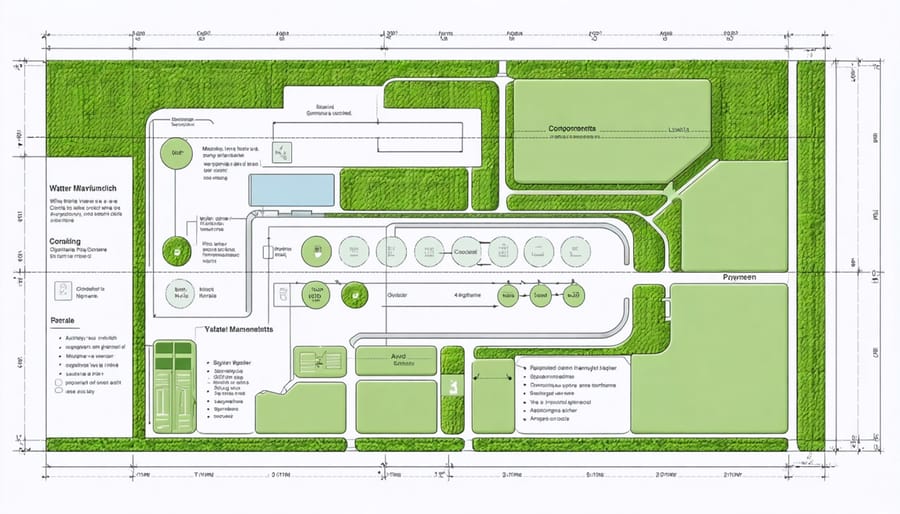
Maintenance Best Practices
Regular maintenance is crucial for ensuring your decentralized water system operates efficiently for years to come. Start by establishing a monthly inspection routine to check all system components, including pumps, filters, and storage tanks. Keep detailed maintenance logs to track system performance and identify potential issues early.
During winter months, protect your system from freezing by properly insulating exposed pipes and ensuring pump houses maintain adequate temperatures above 5°C. Clean filters according to manufacturer specifications, typically every 3-6 months, and inspect storage tanks annually for sediment buildup or damage.
Test water quality quarterly using approved testing kits, and maintain records of results. Consider partnering with neighbouring farms to share maintenance expertise and resources. Many successful Alberta farmers schedule professional inspections annually to complement their regular maintenance routine.
Remember to stock essential spare parts and have emergency contact information readily available for qualified technicians. Taking these proactive steps will help maximize your grant investment and ensure reliable water access for your agricultural operations throughout the year.
As we’ve explored throughout this guide, the Rural Decentralized Water Systems Grant Program offers Alberta farmers a valuable opportunity to enhance their water infrastructure while promoting sustainable agricultural practices. The program’s funding of up to 50% of eligible project costs, with a maximum of $75,000, can significantly reduce the financial burden of implementing these essential systems.
Remember that success in securing this grant starts with thorough preparation. Begin by conducting a comprehensive water needs assessment for your farm, gathering necessary documentation, and developing a detailed project timeline. Consider connecting with local agricultural extension offices or consulting with farmers who have successfully implemented similar systems.
The next steps are straightforward: review the eligibility criteria carefully, prepare your application well before the deadline, and ensure all supporting documents are current and accurate. Don’t hesitate to reach out to program administrators for clarification – they’re there to help you succeed.
For those ready to move forward, applications are accepted on a rolling basis throughout the year. We encourage you to start your application process early, as funds are distributed on a first-come, first-served basis. Remember that investing in sustainable water infrastructure not only benefits your farm operations today but also helps build resilience for future generations of Canadian farmers.
Contact your local agricultural office to begin your application journey and take the first step toward improving your farm’s water management system.

